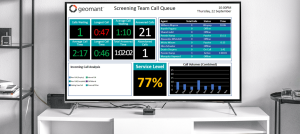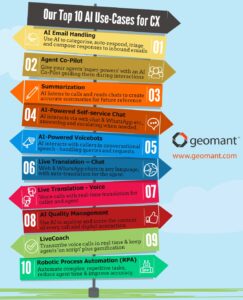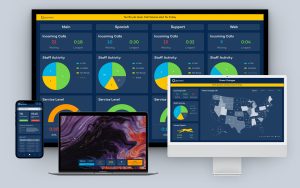Customer experience is the ultimate form of differentiation today. More than features, price, and countless other factors, the loyalty of your clients depends on the experience you offer. However, it’s important to note that customer experience (CX) isn’t just for retail companies or service providers. Educational facilities also need to deliver the right quality of service too.
Careers in education aren’t the most common example of a “customer service” role. However, failure to deliver the right meaningful moments could mean you struggle to attract new alumni or miss out on branding opportunities. One study conducted in the UK found that excellent experience even reduces the number of students likely to drop out during their first year of undergraduate education.
Educational facilities, from schools to universities, need to earn the trust of their community to thrive. After all, no-one wants to spend years of their life in an environment they don’t trust.
So how do we improve CX in the education environment?
Why Educators Need to Prioritize Customer Experience

Studies show that excellent customer experience leads to customers paying a premium for more services, remaining loyal to a brand, and advocating for that group. In the educational environment, this means that CX can reduce the risk of high tuition prices scaring students away and improve your ability to reach new alumni.
It’s not just students that schools should be considering either. Parents responsible for helping to fund education or encourage enrollment also need to trust the facilities they’re sending their kids to. Parents only want the best for their children. In education, good CX provides:
- A competitive advantage over other schools
- An improved reputation among potential students and parents
- Better chances of diversity in student enrollment
- Higher levels of student loyalty and potential alumni donations
- Increased chances of attracting high-quality faculty members
- Better funding (more students allow for higher funding potential).
So, how can you prepare your school to deliver meaningful experiences?
Step 1: Leverage the right tools

Excellent customer experience starts with better communication.
A strong set of communication tools for your internal faculty improves things like lesson planning, strategizing for school development, and even collaboration between teachers. For today’s fast-paced schooling environments, Microsoft Teams offers an environment where faculty can discuss and explore opportunities at speed.
The Teams environment automatically integrates with learning management systems and other tools for professionals looking to deliver digital opportunities for education. This supports schools in reaching a wider selection of potential students.
With the right partner, companies can even build Microsoft Teams contact centers, and use these environments to keep conversations with parents, students and alumni as positive as possible. Teachers can have one-on-one video meetings with alumni and potential donators or use the contact center to reach out to potential students in bulk.
Administrators and leaders in an educational environment can even use contact center tools in Microsoft Teams like intelligent routing and AI bots to help improve the speed of service provided to parents and students.
Step 2: Support and Empower Faculty

Like many industries, the educational environment is evolving following the pandemic of 2020. Many educational experiences are now more “hybrid”, with students and teachers sometimes operating outside of the traditional lecture hall. Making sure your staff have what it takes to deliver engaging lessons both in and outside of the school building is essential.
Tools like Microsoft Teams don’t only improve staff collaboration – they can also pave the way for better educational experiences for students too. Whiteboarding sessions for brainstorming, integrations with AI tools for student engagement, and group video conferencing sessions can all help to ensure that students remain engaged wherever they are.
At the same time, the right Microsoft Teams partner can use the open API environment of Teams to add further integrations with things like tracking and analytics tools to examine student engagement. This could improve any schools understanding of what students need to effectively learn.
Some educational facilities may even look into implementing analytics tools and wallboards to help them track things like the sentiment of their customers, and the overall satisfaction levels of students throughout different times of the year.
Step 3: Focus on Availability and Responsivity

Teachers and educational facilities aren’t just trying to make a profit- they’re actively shaping the world into a better place, by raising a generation of innovators. Improving customer experience in this environment means understanding the impact you have on the lives of your students.
Educational professionals need to take an empathetic approach to their service strategy. This means understanding that speed and responsivity is often key to keeping consumers happy. Your students can’t afford to wait days for a response about their upcoming deadline. Parents worried about an issue on campus won’t want to wait long to hear back from a teacher.
Educational companies can start by offering self-service FAQs and guidance on their website for anyone who might want to find answers to their own questions. However, this guidance shouldn’t come at the expense of a responsive service strategy.
As much as possible, today’s educators will need to ensure there’s always someone available to respond to customer questions as quickly as possible. This could even mean implementing tools to help route queries to the right administrators and experts.
Step 4: Be Flexible

The educational environment can be an unpredictable space, particularly when it comes to customer service. You’ll need to be prepared for the peaks in demand that naturally occur during things like enrollment season, or examination periods. Having access to additional administration or call center agents during this time could help to reduce the number of people you leave waiting on hold.
Being flexible also means ensuring you give people a variety of ways to engage with your educational facility. As remote education becomes more common, it may be easier for you to have initial interviews with potential students via video, rather than asking people to travel through towns and cities to visit your campus.
Similarly, you can download add-ons and plugins for Microsoft Teams and similar tools which can allow students to sign documents digitally or download a prospectus directly to their smartphone or tablet. Think about the kind of flexible support your students, parents, and other customers might need as the educational landscape continues to evolve.
To ensure you’re ready for anything, it pays to implement an analytics strategy into your existing communication strategy. Reporting and insights will help you to gather information about how your customers prefer to interact with you, and what kind of tools they use most often.
The more information you collect, the easier it will be to see whether you need to invest more in things like people to man your instant chat environment, or professionals who can respond to student and parent inquiries over the phone.
Step 5: Focus on Adaptability

Finally, the students and academics that today’s educational facilities support are a world away from the students we had a few decades ago. Since the pandemic in particular, new technology has begun to thrive in the digital space at an incredible rate. We now have everything from virtual and remote learning opportunities to VR and AR in the educational space.
Like modern business owners, today’s educators will need to be ready to adapt to suit a new generation of future students. This means embracing a communication, collaboration, and innovation strategy that’s flexible and dynamic. A cloud-based environment for communicating with staff and students should provide facilities with the flexibility they need to evolve at a pace that suits their community. What’s more, the cloud makes it easy to roll new technology out to educators who might not be in the same environment as you.
Make sure you’re ready to adapt by building your communication landscape on an adaptable and flexible foundation. Then, prepare yourself for constant innovation and growth by collecting as much feedback as possible from your students, alumni, and other contacts. The more information you can gather, the easier it will be to predict where your school is headed.
Bring Customer Experience into Education
Customer experience is something that all companies should be thinking about more carefully. It doesn’t matter whether you’re selling retail items, or an education, your community will always be looking for the best, most personalized experiences.
Learning how to bring customer experience elements into education will ensure you can continue to attract students and delight them for years to come.
{{cta(‘e084389f-22c2-4817-baff-eb329d1e57d5’)}}











